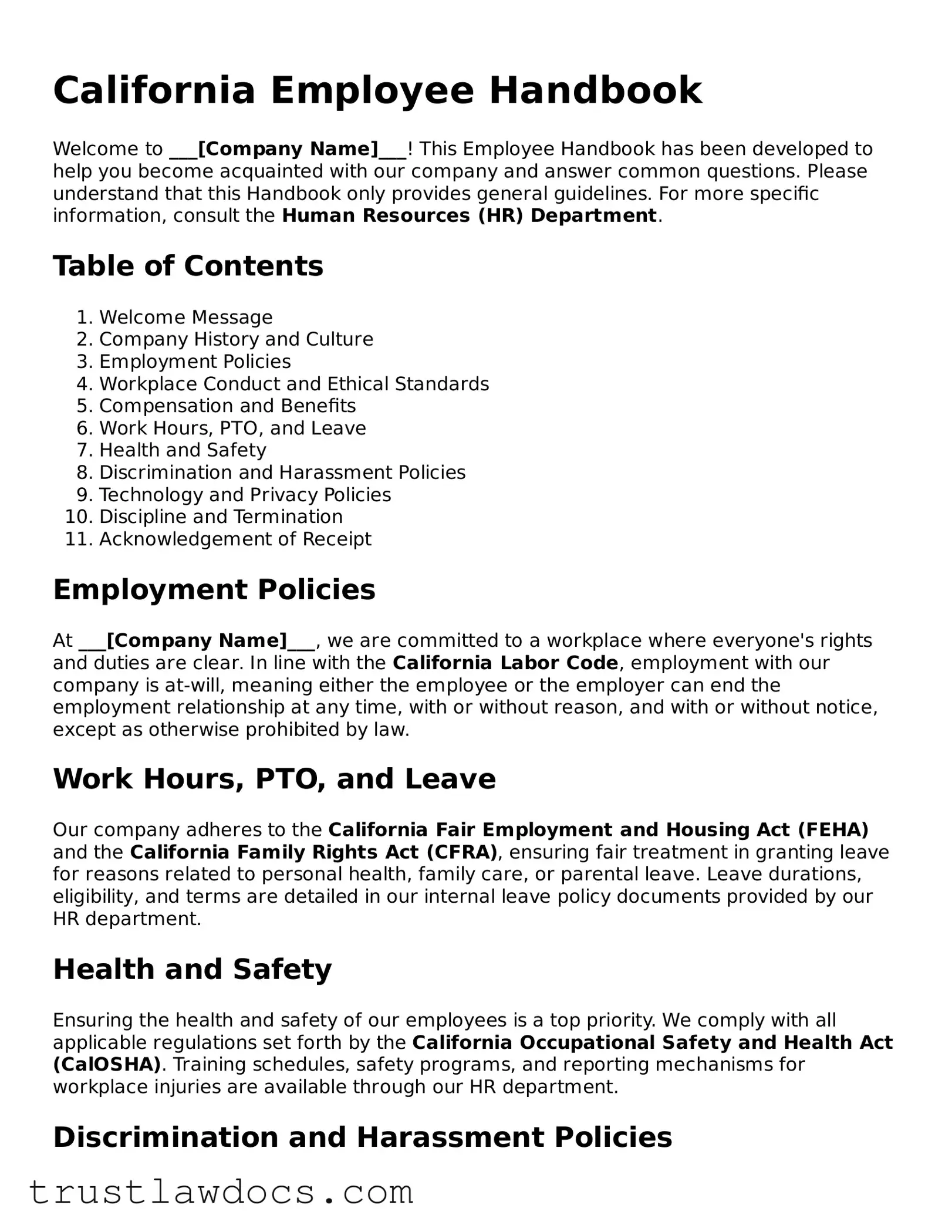California Employee Handbook
Welcome to ___[Company Name]___! This Employee Handbook has been developed to help you become acquainted with our company and answer common questions. Please understand that this Handbook only provides general guidelines. For more specific information, consult the Human Resources (HR) Department.
Table of Contents
- Welcome Message
- Company History and Culture
- Employment Policies
- Workplace Conduct and Ethical Standards
- Compensation and Benefits
- Work Hours, PTO, and Leave
- Health and Safety
- Discrimination and Harassment Policies
- Technology and Privacy Policies
- Discipline and Termination
- Acknowledgement of Receipt
Employment Policies
At ___[Company Name]___, we are committed to a workplace where everyone's rights and duties are clear. In line with the California Labor Code, employment with our company is at-will, meaning either the employee or the employer can end the employment relationship at any time, with or without reason, and with or without notice, except as otherwise prohibited by law.
Work Hours, PTO, and Leave
Our company adheres to the California Fair Employment and Housing Act (FEHA) and the California Family Rights Act (CFRA), ensuring fair treatment in granting leave for reasons related to personal health, family care, or parental leave. Leave durations, eligibility, and terms are detailed in our internal leave policy documents provided by our HR department.
Health and Safety
Ensuring the health and safety of our employees is a top priority. We comply with all applicable regulations set forth by the California Occupational Safety and Health Act (CalOSHA). Training schedules, safety programs, and reporting mechanisms for workplace injuries are available through our HR department.
Discrimination and Harassment Policies
We are committed to creating a workplace free of discrimination and harassment, in line with California's Fair Employment and Housing Act (FEHA). Our policies strictly prohibit harassment or discrimination based on race, color, national origin, age, sex, religion, disability, genetic information, sexual orientation, gender identity or expression, or any other characteristic protected by law. Procedures for reporting and resolving complaints are detailed in our internal policies.
Technology and Privacy Policies
In today's digital age, it's essential to clarify the use of company technology. Usage guidelines, along with privacy expectations regarding internet use, email communications, and data management, are outlined, per California's Electronic Communications Privacy Act (CalECPA). This law protects employees' privacy rights while ensuring company property is used appropriately.
Discipline and Termination
We believe in fair and transparent disciplinary practices. Termination of employment, whether initiated by the employer or employee, will be conducted in accordance with state laws, including the California Labor Code. Detailed procedures for disciplinary action and termination are available from the HR department.
Acknowledgement of Receipt
All employees are required to acknowledge receipt of this Employee Handbook. This acknowledgment does not create a contract of employment but is a confirmation of understanding the policies and expectations of ___[Company Name]___.
Employee Signature: _________________________ Date: _____________
HR Department Signature: _________________________ Date: _____________
